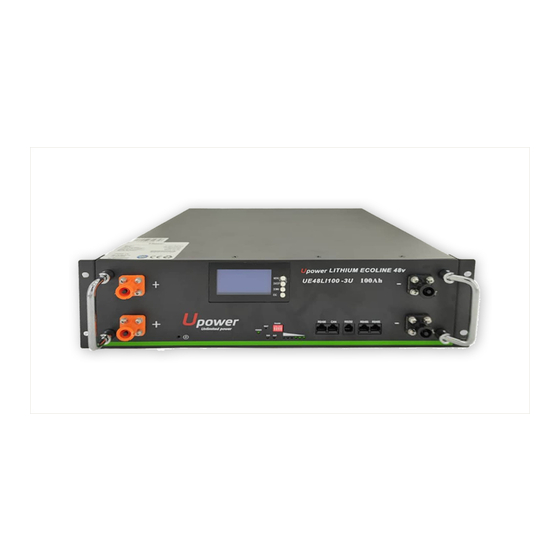
Summary of Contents for UPOWER Ecoline UE48LI100-3U
- Page 1 Energy Storage Lithium Battery Module User Manual 48V100Ah LFP Product Information Version: 1.0...
- Page 2 48V100Ah - Energy Storage Lithium Battery Module - User Manual 1. Battery Panel Functions This RS485 interface is used for battery and inverter communication Address dip switch: The two 485 communication ports identifies addresses when batteries use a communication connection are connected in parallel between the batteries Battery anode:...
- Page 3 48V100Ah - Energy Storage Lithium Battery Module - User Manual Normal Flash 3 Warn Flash 3 Flash 3 Stop Charging Discharge Mode Low Voltage Protection Stop Discharging Temperature or Current Protection Stop Discharging Light State Light Flash 1 0.25S 3.75S Flash 2 0.5S 0.5S...
- Page 4 48V100Ah - Energy Storage Lithium Battery Module - User Manual RS485 RS485 terminal: (RJ45 port) the RS485 terminal outputs battery information. The default baud rate is 9600 bps. When batteries are deployed in parallel, you need to set the address of each battery using a dip switch. Pin Definitions of the RS485 Port Function Definition Pin Number...
- Page 5 48V100Ah - Energy Storage Lithium Battery Module - User Manual Schematic diagram of battery parallel installation Inverter design Note: When multiple batteries are connected in parallel, the battery at address 1 communicates with the inverter, and the order battery addresses are coded from address 2 Note: The battery should be turned off during installation.
-
Page 6: Installation Tools
48V100Ah - Energy Storage Lithium Battery Module - User Manual 2. Installation Tools Attention before installation: 2.1 Insulation tools should be used to prevent short circuit during installation. 2.2 Power terminal installation must be checked for tightening, whether there is rust, corrosion or other foreign bodies, if there should be wipe Clean, tighten the bolt, the battery bolt virtual connection will lead to the connection voltage drop is too large, even when the current is large The heat burned the battery. - Page 7 48V100Ah - Energy Storage Lithium Battery Module - User Manual 3.2 Place the batteries to be installed into the rack one by one, and install the screws that secure the batteries to the rack. 3.3 Connect the negative wires: After the battery is fixed, connect all the negative terminals of the battery together, and finally connect the negative terminal of the inverter DC input to the negative terminal of the battery.
- Page 8 48V100Ah - Energy Storage Lithium Battery Module - User Manual 3.6 Connect the communication cable between the battery and the inverter: This end connects to the Remote Box of the inverter This port connects to the RS485 port of the battery Note: This communication line should be connected with attention to the direction Paseo de Extremadura, 39 - 28935 Móstoles - Madrid (Spain)
-
Page 9: Troubleshooting Steps
48V100Ah - Energy Storage Lithium Battery Module - User Manual 3.7 Setting the Battery Address: After the preceding operations are complete, set the IP address of the battery connected to the inverter to 1, and set other IP addresses from 2 until all the Settings are complete. Note: The address of the battery must not be the same. -
Page 10: Emergency Measures
48V100Ah - Energy Storage Lithium Battery Module - User Manual If there is no voltage output after the battery is restarted, connect the battery to the host computer and check whether the battery voltage and temperature are normal. Generally cannot discharge the reason is: temperature protection, over current protection, under voltage protection. 5.




Need help?
Do you have a question about the UE48LI100-3U and is the answer not in the manual?
Questions and answers